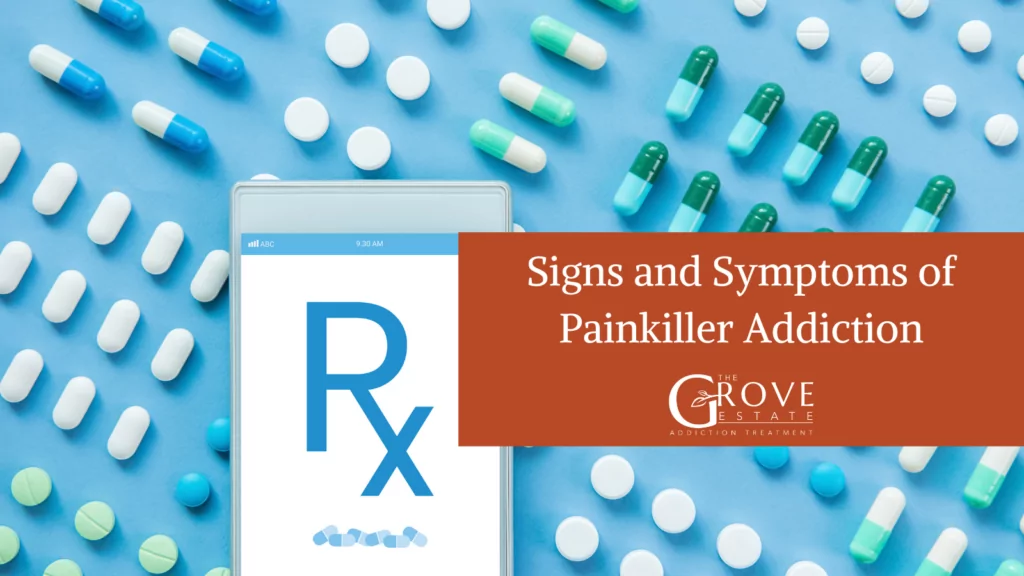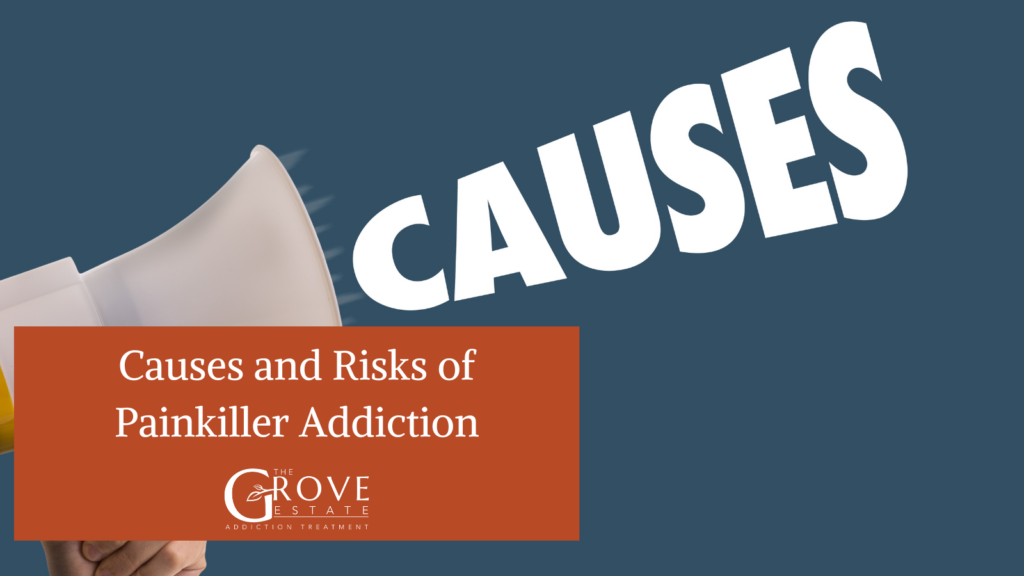Painkiller addiction now called Opioid Use Disorder is a form of substance abuse where an individual becomes dependent on painkillers. More often than not, the class of painkillers involved is called opioids. These opioids are prescribed to manage moderate to severe pain. They are highly addictive which poses significant risks, potentially causing both physical and psychological harm.
Common opioids that are prone to misuse include oxycodone, hydrocodone, morphine, and fentanyl. Prolonged use of these medications can lead to the development of tolerance. Here, the individual needs higher doses to achieve the same pain-relieving effects and physical dependence, causing withdrawal symptoms when the drug is not taken.
Those grappling with painkiller addiction often exhibit varied symptoms. These include drug cravings, and withdrawal symptoms in the absence of the drug. They also show an inability to control drug use despite facing negative consequences.
Painkiller addiction impacts individuals across all age groups. However, with appropriate treatment and support, it is possible to overcome this addiction and lead a healthy and fulfilling life. Treatment often involves a combination of medical detoxification, behavioral therapies, counseling, and support groups.

Signs and Symptoms of Painkiller Addiction
Identifying the signs and symptoms of painkiller addiction is important for early intervention and effective treatment. The signs of a painkiller addiction vary. It is typically based on factors such as the type of medication, dosage, frequency of use, and individual circumstances such as underlying health conditions. Here are common signs indicative of painkiller addiction:
- Taking more frequently than prescribed.
- Consuming higher doses than prescribed.
- Persisting in medication use even after experiencing adverse consequences.
- Using the medicine for purposes other than pain relief, such as seeking euphoria or relaxation.
- Hiding drug use from others, accompanied by noticeable changes in behavior.
Physical Symptoms of Painkiller Addiction
Painkiller addiction often presents with observable physical symptoms, which may include:
- Constipation and digestive problems.
- Insomnia and other sleep disorders.
- Changes in appetite lead to extreme weight loss.
- Increased heart rate.
- Lethargy or drowsiness.
- Vomiting and nausea.
- Tremors, sweating, and muscle pains.
- Severe headaches or dizziness.
- Impaired speech or slurred speech.
- Skin irritations from injection drugs.
Note: Some physical symptoms may be related to the initial medical condition for which the prescription was given.
Psychological Symptoms of Painkiller Addiction
In addition to physical manifestations, painkiller addiction can elicit various psychological symptoms, including:
- Frequent mood changes, such as depression, irritability, or anxiety.
- Feelings of distrust or paranoia.
- Hallucinations or delusions.
- Increased risk-taking behavior.
- Agitation or restlessness.
- Lack of interest in previously enjoyed hobbies.
- Emotional distress, mood swings, and instability.
- Suicidal behavior or thoughts.

Causes and Risks of Painkiller Addiction
Using an opioid for more than 5 days consecutively increases the risk of a painkiller addiction. However, the development of an addiction to prescription painkillers involves a combination of various factors.
Genetic Factors
Ducci F and Goldman D. published an article titled: “The genetic basis of addictive disorders” in 2012 that established a significant link between genetics and addiction. Family history plays a crucial role in understanding the risk of addiction, as individuals with shared genes may be more vulnerable to substance abuse.
Specific genes have been identified that could make a person predisposed to abusing substances, including prescription pain medications. Those with a family history of addiction may possess genes that increase susceptibility to substance abuse.
Environmental Influences
A person’s environment can significantly influence the likelihood of prescription pain medication abuse. Factors include:
- Accessibility: If obtaining painkillers is easy, the risk of abuse is higher.
- Stressful Environments: High-stress environments, whether at home or work, can contribute to the abuse of prescription medications.
- Mental Health Conditions: Individuals struggling with mental health issues may turn to painkillers as a coping mechanism, especially if lacking appropriate coping skills.
- Occupational Hazards: Certain occupations with a higher risk of injury may increase the likelihood of prescription painkiller abuse if an individual sustains an injury while working.
- History of Chronic Pain: Individuals with a history of chronic pain from medical conditions or injuries may be at increased risk.
Treatment and Recovery of Painkiller Addiction
Effective treatment for painkiller addiction involves a comprehensive approach that combines medication-assisted treatment (MAT) with behavioral therapies. Here are the key components of the treatment process:
Medication-Assisted Treatment (MAT)
FDA-Approved Medications: There are FDA-approved medications specifically designed to treat Opioid Use Disorder (OUD). These medications include
| Medication | Effect |
| Buprenorphine | Helps manage withdrawal symptoms, reduce cravings, and support recovery. |
| Methadone | A long-acting opioid agonist that helps prevent withdrawal symptoms and reduce cravings. |
| Naltrexone | Blocks the effects of opioids and helps prevent relapse. |
Whole-Person Approach: MAT, when combined with counseling and behavioral therapies, provides a holistic approach proven to be effective in addressing the complexities of addiction.
Behavioral Therapy for Painkiller Addicts
Behavioral therapy is another aspect of treating painkiller addiction. It focuses on managing cravings and helping individuals develop positive habits and thoughts essential for sustained recovery. The individual also learns to implement strategies to avoid triggers that may lead to relapse.
The versatility of behavioral therapy is evident in its adaptation to individual, family, or group settings. This provides a more holistic treatment experience. Various life domains can be explored thus allowing for a well-rounded and enduring recovery journey for individuals combating painkiller addiction.
Naloxone Kit and Overdose Prevention
Naloxone is an opioid antagonist designed to rapidly reverse opioid overdose. If you are struggling with painkiller addiction, a naloxone kit is something you should have handy. It is a life-saving intervention that can reverse potentially fatal overdoses swiftly by blocking the effects of opioids.
Widely accessible in all 50 states, naloxone is typically available without a prescription, ensuring its availability for those who may need it. To ensure proper utilization, individuals are strongly encouraged to consult with healthcare professionals, including doctors or pharmacists, to obtain a naloxone kit and receive guidance on its correct usage.
What are the long-term effects of painkiller addiction?
Long-term painkiller addiction can lead to severe physical health issues, cognitive impairments, and mental health challenges. Socially, it strains relationships, hinders academic or professional performance, and may result in legal and financial difficulties.
Are there withdrawal symptoms associated with painkiller addiction?
Yes, individuals with painkiller addiction often experience withdrawal symptoms when the drug is not taken. These symptoms can include cravings, insomnia, nausea, vomiting, muscle pains, increased heart rate, and heightened anxiety. The severity of withdrawal symptoms can vary depending on factors such as the type of medication, dosage, and duration of use.
Can painkiller addiction lead to other substance addictions?
Painkiller addiction can sometimes act as a gateway to the misuse of other substances, including illegal drugs or alcohol, as individuals seek to achieve similar euphoric effects or manage withdrawal symptoms. According to the American Psychological Association, this progression is particularly concerning due to the increased risk of overdose and the complex challenges of treating multiple substance dependencies.
To mitigate these risks, it’s important to seek comprehensive treatment that addresses the root causes of addiction. Individual counseling and support groups can be effective in preventing the escalation to other substance use by offering emotional support and coping strategies. Additionally, being aware of the potential for cross-addiction can help individuals in recovery make informed decisions about their health and avoid substances with a high potential for addiction, such as marijuana addiction.

Share This Post



